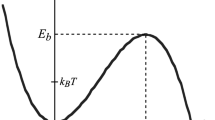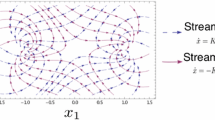Abstract
It is shown that the Fokker-Planck operator can be derived via a projection-perturbation approach, using the repartition of a more detailed operatorℒ into a perturbationℒ 1 and an unperturbed partℒ 0. The standard Fokker-Planck structure is recovered at the second order inℒ 1, whereas the perturbation terms of higher order are shown to provoke the breakdown of this structure. To get rid of these higher order terms, a key approximation, local linearization (LL), is made. In general, to evaluate at the second order inℒ 1 the exact expression of the diffusion coefficient which simulates the influence of a Gaussian noise with a finite correlation timeτ, a resummation up to infinite order inτ must be carried out, leading to what other authors call the best Fokker-Planck approximation (BFPA). It is shown that, due to the role of terms of higher order inℒ 1, the BFPA leads to predictions on the equilibrium distributions that are reliable only up to the first order in t. The LL, on the contrary, in addition to making the influence of terms of higher order inℒ 1 vanish, results in a simple analytical expression for the term of second order that is formally coincident with the complete resummation over all the orders in t provided by the Fox theory. The corresponding diffusion coefficient in turn is shown to lead in the limiting case τ→∞ to exact results for the steady-state distributions. Therefore, over the whole range 0⩽τ⩽∞ the LL turns out to be an approximation much more accurate than the global linearization proposed by other authors for the same purpose of making the terms of higher order inℒ 1 vanish. In the short-τ region the LL leads to results virtually coincident with those of the BFPA. In the large-τ region the LL is a more accurate approximation than the BFPA itself. These theoretical arguments are supported by the results of both analog and digital simulation.
Similar content being viewed by others
References
M. W. Evans, P. Grigolini, and G. Pastori Parravicini, eds.,Memory Function Approaches to Stochastic Problems in Condensed Matter (Wiley, New York, 1985).
M. San Miguel and J. M. Sancho,Phys. Lett. 76A:97 (1980).
H. Dekker,Phys. Lett. 90A:26 (1982).
R. F. Fox,Phys. Lett. 94A:281 (1983).
P. Hanggi, inStochastic Processes Applied to Physics, L. Pesquera and E. Santos, eds. (Heyden, Philadelphia, 1985); P. Hanggi,Springer Lecture Notes in Physics (Springer-Verlag, 1984).
P. Hanggi, F. Marchesoni, and P. Grigolini,Z. Phys. B 56:333 (1984).
P. Hanggi, T. J. Mroczkowsky, F. Moss, and P. V. E. McClintock,Phys. Rev. A 32:695 (1985).
P. Grigolini, inAdvances in Nonlinear Dynamics and Stochastic Processes, R. Livi and A. Politi, eds. (World Scientific, Singapore, 1985).
R. Fox,Phys. Rev. A 33:467 (1986);34:4525 (1986).
L. Garrido and J. M. Sancho,Physica 115A:479 (1982).
J. M. Sancho, M. San Miguel, S. L. Katz, and J. D. Gunton,Phys. Rev. A 26:1589 (1982).
J. M. Sancho, F. Sagues, and M. San Miguel,Phys. Rev. A 33:3399 (1986).
K. Lindenberg and B. J. West,Physica 119A:485 (1983).
P. Grigolini,Phys. Lett. 119A:157 (1986).
J. Masoliver, B. J. West, and K. Lindenberg,Phys. Rev. A 35:3086 (1987).
R. Zwanzig,J. Chem. Phys. 33:1338 (1960).
P. Grigolini,Mol. Phys. 30:1874 (1974).
P. Grigolini and A. Lami,Chem. Phys. 30:61 (1978).
S. Mukamel, I. Oppenheim, and J. Ross,Phys. Rev. A 17:1988 (1978).
N. G. van Kämpen,Phys. Rep. 24C:171 (1976).
E. Peacok-Lopez, K. Lindenberg, and B. West, work in preparation.
P. Grigolini and F. Marchesoni,Adv. Chem. Phys. 62:29 (1985).
R. F. Fox and R. Roy,Phys. Rev. A 35:1838 (1987).
L. Lugiato and R. J. Horowitz,J. Opt. Soc. Am. 2B:971 (1985).
G. Tsironis and P. Grigolini,Phys. Rev. Lett., submitted.
S. Faetti and P. Grigolini,Phys. Rev. A 36:441 (1987).
J. H. Ahrens and U. Dieter,Math. Comp. 27:927 (1983).
L. Fronzoni, P. Grigolini, P. Hanggi, F. Moss, R. Mannella, and P. V. E. McClintock,Phys. Rev. A 33:3320 (1986).
Author information
Authors and Affiliations
Rights and permissions
About this article
Cite this article
Faetti, S., Fronzoni, L., Grigolini, P. et al. The projection approach to the Fokker-Planck equation. I. Colored Gaussian noise. J Stat Phys 52, 951–978 (1988). https://doi.org/10.1007/BF01019735
Received:
Revised:
Issue Date:
DOI: https://doi.org/10.1007/BF01019735




